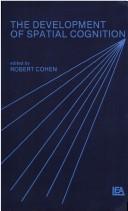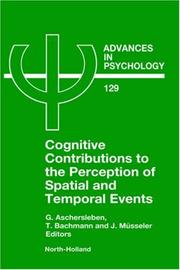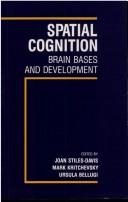| Listing 1 - 10 of 24 | << page >> |
Sort by
|
Article
Abstract | Keywords | Export | Availability | Bookmark
 Loading...
Loading...Choose an application
- Reference Manager
- EndNote
- RefWorks (Direct export to RefWorks)
Activation. --- Amygdala. --- Hippocampus. --- Learning. --- Spatial learning. --- Spatial. --- Stress.

ISBN: 0898595436 Year: 1985 Publisher: Hillsdale (N.J.) Lawrence Erlbaum Associates
Abstract | Keywords | Export | Availability | Bookmark
 Loading...
Loading...Choose an application
- Reference Manager
- EndNote
- RefWorks (Direct export to RefWorks)
Space perception in children --- Child development --- Perception spatiale chez l'enfant --- Enfants --- Développement --- Child Development. --- Child. --- Infant. --- Space Perception. --- Perception in children --- Child study --- Children --- Development, Child --- Developmental biology --- Developmental psychobiology --- Child rearing --- Perception, Space --- Perceptions, Space --- Space Perceptions --- Spatial Learning --- Infants --- Minors --- Infant Development --- Development, Infant --- Psychology, Child --- Growth --- Development --- Développement --- Child --- Child Development --- Infant --- Space Perception --- Child development.
Article
Abstract | Keywords | Export | Availability | Bookmark
 Loading...
Loading...Choose an application
- Reference Manager
- EndNote
- RefWorks (Direct export to RefWorks)
This study examined the effects of enriching the environment on the learning abilities of growing pigs. Eighty-four pigs were housed in either barren or enriched environments from birth to 14 weeks. The barren environments were defined as intensive housing and the enriched environments incorporated extra space, including areas which contained peat and straw in a rack. The learning abilities of pigs from both environments were tested at 15-17 weeks using an operant task which involved pigs learning to push a panel for a reward and a maze test which involved spatial learning. Pigs from enriched environments learned both the operant task and the maze task more rapidly than their counterparts from barren environments. These results suggest that the cognitive development of pigs may be impaired in intensive housing systems
Ability. --- Animal welfare,environmental enrichment,learning,pigs. --- Animals. --- Area. --- Behavior. --- Birth. --- Brain. --- Development. --- Enriched environment. --- Enriched. --- Enrichment. --- Environment. --- Environmental enrichment. --- Environments. --- Experience. --- Growing pigs. --- Growing-pigs. --- Housing system. --- Housing. --- Increases. --- Learning ability. --- Learning-ability. --- Learning. --- Performance. --- Pig. --- Pigs. --- Rats. --- Reward. --- Space. --- Spatial learning. --- Spatial. --- Stimulation. --- Straw. --- System. --- Systems. --- Task. --- Test. --- Welfare.
Article
Abstract | Keywords | Export | Availability | Bookmark
 Loading...
Loading...Choose an application
- Reference Manager
- EndNote
- RefWorks (Direct export to RefWorks)
Spatial learning and memory involves the ability to encode geometric relationships between perceived cues and depends critically on the hippocampus. Visually guided spatial learning has been demonstrated in adult animals. As infant animals rely heavily on olfaction, olfactory based spatial learning was assessed in infant mice. When 12-day-old pups were displaced from their nest, they learned within a few training trials to use the spatial pattern of odor cues to move back to the nest. However, mouse pups that over-expressed Ca2+/calmodulin-dependent protein kinase (CaMKII) in hippocampal neurons were impaired in olfactory based spatial learning. NeuroReport 11:1051-1055 (C) 2000 Lippincott Williams & Wilkins
Ability. --- Adult. --- Animal. --- Animals. --- Autophosphorylation. --- Camkii. --- Cues. --- Dependence. --- Hippocampal-neurons. --- Hippocampal. --- Hippocampus. --- Homing pigeons. --- Infant. --- Learning. --- Ltp. --- Mammals. --- Memory. --- Mice. --- Mouse pup. --- Mouse. --- Navigation. --- Neonatal. --- Nest. --- Neurons. --- Odor. --- Olfaction. --- Olfactory. --- Ontogeny. --- Pattern. --- Protein kinase-ii. --- Protein. --- Pups. --- Rats. --- Spatial learning. --- Spatial. --- Threonine-286. --- Training.

ISBN: 0444503250 9780444503251 0585473862 9780585473864 9780080502175 0080502172 Year: 1999 Publisher: Amsterdam ; New York : Elsevier,
Abstract | Keywords | Export | Availability | Bookmark
 Loading...
Loading...Choose an application
- Reference Manager
- EndNote
- RefWorks (Direct export to RefWorks)
Affective and dynamic functions --- Cognitive psychology --- Space perception. --- Time perception. --- Cognition. --- Space perception --- Time perception --- Cognition --- Space Perception. --- Time Perception. --- Psychology --- Chronometry, Mental --- Duration, Intuition of --- Intuition of duration --- Mental chronometry --- Time --- Time, Cognition of --- Time estimation --- Orientation (Psychology) --- Perception --- Spatial perception --- Spatial behavior --- Figure-ground perception --- Geographical perception --- Temporal Perception --- Temporal Processing --- Time Processing --- Perception, Temporal --- Perception, Time --- Processing, Temporal --- Processing, Time --- Cognitive Function --- Cognitions --- Cognitive Functions --- Function, Cognitive --- Functions, Cognitive --- Perception, Space --- Perceptions, Space --- Space Perceptions --- Spatial Learning

ISBN: 0805800468 0805800786 9780805800784 Year: 1988 Publisher: Hillsdale, N.J. Erlbaum
Abstract | Keywords | Export | Availability | Bookmark
 Loading...
Loading...Choose an application
- Reference Manager
- EndNote
- RefWorks (Direct export to RefWorks)
Cognitive psychology --- Child Development. --- Cognition. --- Space Perception. --- Perception, Space --- Perceptions, Space --- Space Perceptions --- Spatial Learning --- Cognitive Function --- Cognitions --- Cognitive Functions --- Function, Cognitive --- Functions, Cognitive --- Infant Development --- Development, Child --- Development, Infant --- Psychology, Child --- Growth --- Space perception --- Space perception in children --- Neuropsychology --- Physiological aspects --- Congresses --- Child Development --- Cognition --- Space Perception --- Spatial perception --- Perception --- Spatial behavior --- Figure-ground perception --- Geographical perception --- Perception in children --- Physiological aspects&delete& --- Space perception - Physiological aspects - Congresses --- Space perception in children - Congresses --- Neuropsychology - Congresses
Article
Abstract | Keywords | Export | Availability | Bookmark
 Loading...
Loading...Choose an application
- Reference Manager
- EndNote
- RefWorks (Direct export to RefWorks)
Maternal care influences hippocampal development in the rat. The offspring of mothers that exhibit increased levels of pup licking/grooming and arched-back nursing (High LG-ABN mothers) show increased hippocampal N-methyl-D-aspartate (NMDA) receptor binding and enhanced hippocampal-dependent spatial learning. In these studies we examined whether environmental enrichment from days 22-70 of life might reverse the effects of low maternal care. Environmental enrichment eliminated the differences between the offspring of High and Low LG-ABN mothers in both Morris water maze learning and object recognition. However, enrichment did not reverse the effect of maternal care on long-term potentiation in the dentate gyrus or on hippocampal NMDA receptor binding. In contrast, peripubertal enrichment did reverse the effects of maternal care on hippocampal a-amino-3-hydroxy-5-methyl-4-isoxazolepropionic acid receptor binding. These findings provide evidence for the reversal of the effects of reduced maternal investment in early life on cognitive function in adulthood. Such effects might involve compensatory changes associated with peripubertal enrichment. (C) 2003 IBRO. Published by Elsevier Science Ltd. All rights reserved
Adulthood. --- Ampa receptors. --- Care. --- Cognitive function. --- Dentate gyrus. --- Development. --- Enrichment. --- Environmental enrichment. --- Expression. --- Function. --- Hippocampal. --- Investment. --- Learning. --- Level. --- Life. --- Long-term potentiation. --- Long-term. --- Maternal care. --- Maternal investment. --- Maternal-care. --- Maternal. --- Maze learning. --- Memory. --- Mice. --- Morris water maze. --- Mother. --- Nmda receptor. --- Nursing. --- Object recognition. --- Object. --- Parental care,enriched,cognition,glutamate receptors. --- Plasticity. --- Potentiation. --- Prenatal stress. --- Rat hippocampus. --- Rat. --- Receptor antagonist. --- Receptor-binding. --- Receptor. --- Recognition. --- Responses. --- Spatial learning. --- Spatial.
Article
Year: 2004
Abstract | Keywords | Export | Availability | Bookmark
 Loading...
Loading...Choose an application
- Reference Manager
- EndNote
- RefWorks (Direct export to RefWorks)
Maternal care in the rat influences the development of cognitive function in the offspring through neural systems known to mediate activity-dependent synaptic plasticity. The offspring of mothers that exhibit increased levels of pup licking/grooming (high-LG mothers) show increased hippocampal N-methyl-D-aspartate (NMDA) subunit mRNA expression, enhanced synaptogenesis and improved hippocampal-dependent spatial learning in comparison with animals reared by low-LG mothers. The effects of reduced maternal care on cognitive function are reversed with peripubertal environmental enrichment; however, the neural mechanisms mediating this effect are not known. In these studies we exposed the offspring of high- and low-LG mothers to environmental enrichment from days 22 to 70 of life, and measured the expression of genes encoding for glutamate receptor subunits and synaptophysin expression as a measure of synaptic density. Environmental enrichment reversed the effects of maternal care on synaptic density and this effect was, in turn, associated with a reversal of the effect of maternal care on the NR2A and NR2B subunits of the NMDA receptor, as well as effects on (RS)-alpha-amino-3-hydroxy-5-methyl-4-isoxazolepropionic acid (AMPA) receptor subunits. Finally, direct infusion of an NR2B-specific NMIDA receptor antagonist into the hippocampus eliminated the effects of maternal care on spatial learning/memory in the Morris water maze. These findings suggest that: (1) the effects of maternal care are mediated by changes in NR2B gene expression; and (2) that environmental enrichment reverses the effects of reduced maternal care through the same genomic target, the NR2B gene, and possibly effects on other subunits of the NMIDA and AMPA receptors
Aged rats. --- Ampa receptors. --- Animal. --- Animals. --- Care. --- Cognitive function. --- Density. --- Dentate gyrus. --- Development. --- Enrichment. --- Environmental enrichment. --- Expression. --- Function. --- Gene-expression. --- Gene. --- Genes. --- Glutamate receptors. --- Glutamate. --- Hippocampal. --- Hippocampus. --- Immediate-early gene. --- Learning. --- Level. --- Life. --- Long-term potentiation. --- Maternal care. --- Maternal-care. --- Maternal. --- Mechanisms. --- Memory consolidation. --- Messenger-rna. --- Morris water maze. --- Mother. --- Mothers. --- Neural systems. --- Nmda receptor. --- Plasticity. --- Rat hippocampus. --- Rat. --- Receptor antagonist. --- Receptor. --- Receptors. --- Spatial learning. --- Spatial memory. --- Spatial. --- Synaptic plasticity. --- System. --- Systems. --- Time. --- Water maze.
Article

Year: 2003
Abstract | Keywords | Export | Availability | Bookmark
 Loading...
Loading...Choose an application
- Reference Manager
- EndNote
- RefWorks (Direct export to RefWorks)
Human performance on diverse tests of intellect are impacted by a "general" regulatory factor that accounts for up to 50% of the variance between individuals on intelligence tests. Neurobiological determinants of general cognitive abilities are essentially unknown, owing in part to the paucity of animal research wherein neurobiological analyses are possible. We report a methodology with which we have assessed individual differences in the general learning abilities of laboratory mice. Abilities of mice on tests of associative fear conditioning, operant avoidance, path integration, discrimination, and spatial navigation were assessed. Tasks were designed so that each made unique sensory, motor, motivational, and information processing demands on the animals. A sample of 56 genetically diverse outbred mice (CD-1) was used to assess individuals' acquisition on each task. Indicative of a common source of variance, positive correlations were found between individuals' performance on all tasks. When tested on multiple test batteries, the overall performance ranks of individuals were found to be highly reliable and were "normally" distributed. Factor analysis of learning performance variables determined that a single factor accounted for 38% of the total variance across animals. Animals' levels of native activity and body weights accounted for little of the variability in learning, although animals' propensity for exploration loaded strongly ( and was positively correlated) with learning abilities. These results indicate that diverse learning abilities of laboratory mice are influenced by a common source of variance and, moreover, that the general learning abilities of individual mice can be specified relative to a sample of peers
Ability. --- Acquisition. --- Activity. --- Analysis. --- Animal. --- Animals. --- Avoidance. --- Body weight. --- Body-weight. --- Brain. --- Cognitive-ability. --- Conditioning. --- Demand. --- Discrimination. --- Enhancement. --- Exploration. --- Expression. --- Fear. --- Genetics. --- Human. --- Individual difference. --- Individual differences. --- Individual-differences. --- Intelligence,general intelligence,fluid intelligence,associative learning,memory,spatial learning,emotional learning,learning systems,genetic variation,behavioral phenotypes. --- Intelligence. --- Laboratory mice. --- Laboratory. --- Learning ability. --- Learning-ability. --- Learning. --- Level. --- Memory. --- Methodology. --- Mice. --- Navigation. --- Performance. --- Rank. --- Rat. --- Research. --- Sensory. --- Spatial. --- System. --- Task. --- Tasks. --- Test. --- Tests. --- Variability. --- Weight.
Book
ISBN: 0262061333 0262561964 0262315750 9780262061339 Year: 1990 Publisher: Cambridge (Mass.): MIT Press,
Abstract | Keywords | Export | Availability | Bookmark
 Loading...
Loading...Choose an application
- Reference Manager
- EndNote
- RefWorks (Direct export to RefWorks)
Space Perception. --- Time Perception. --- Space and time --- Time perception --- Space and time. --- Time perception. --- Hulpwetenschappen --- antropologie en cultuur. --- Chronometry, Mental --- Duration, Intuition of --- Intuition of duration --- Mental chronometry --- Time --- Time, Cognition of --- Time estimation --- Orientation (Psychology) --- Perception --- Space of more than three dimensions --- Space-time --- Space-time continuum --- Space-times --- Spacetime --- Time and space --- Fourth dimension --- Infinite --- Metaphysics --- Philosophy --- Space sciences --- Beginning --- Hyperspace --- Relativity (Physics) --- Perception, Time --- Perceptions, Time --- Time Perceptions --- Perception, Space --- Perceptions, Space --- Space Perceptions --- Spatial Learning --- Theory of relativity. Unified field theory --- Philosophy of science --- Antropologie en cultuur. --- Time Perception --- Space Perception --- Visual Perception --- Mental Processes --- Psychological Phenomena and Processes --- Psychiatry and Psychology --- Psychological Phenomena --- Psychiatry
| Listing 1 - 10 of 24 | << page >> |
Sort by
|

 Search
Search Feedback
Feedback About UniCat
About UniCat  Help
Help News
News